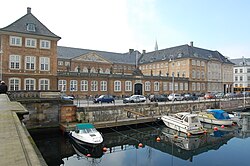
Amalienborg is the official residence for the Danish royal family, and is located in Copenhagen, Denmark. The Danish Head of State, Queen Margrethe ll, resides in the palace during autumn and winter. It consists of four identical classical palace façades with rococo interiors around an octagonal courtyard ; in the centre of the square is a monumental equestrian statue of Amalienborg's founder, King Frederick V.

Christiansborg Palace is a palace and government building on the islet of Slotsholmen in central Copenhagen, Denmark. It is the seat of the Danish Parliament, the Danish Prime Minister's Office, and the Supreme Court of Denmark. Also, several parts of the palace are used by the Danish monarch, including the Royal Reception Rooms, the Palace Chapel and the Royal Stables.
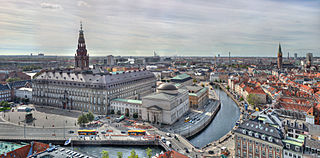
Slotsholmen is an island in the harbour of Copenhagen, Denmark, and part of Copenhagen Inner City. The name is taken from the successive castles and palaces located on the island since Bishop Absalon constructed the city's first castle on the island in 1167 at the site where Christiansborg Palace lies today.
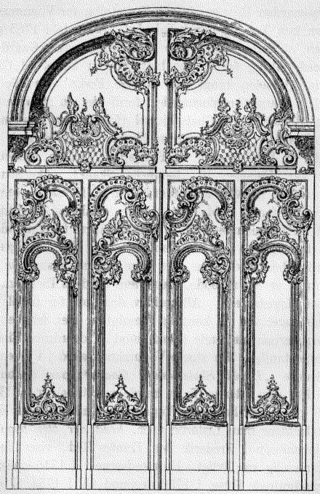
Louis August le Clerc, also known as Louis-Augustin le Clerc, was a French-born sculptor working in Denmark. He was born in Metz, France to copperplate engraver Sebastian le Clerc and his wife Charlotte van den Kerckhove. He was summoned to Denmark at the age of 47, and lived out the rest of his life there as a royal sculptor to the Danish Court and as professor at the Royal Danish Academy of Art. He helped introduce French Rococo artistic ideals to Denmark.

Nicolai Eigtved, also known as Niels Eigtved, was a Danish architect. He introduced and was the leading proponent of the French rococo or late baroque style in Danish architecture during the 1730s–1740s. He designed and built some of the most prominent buildings of his time, a number of which still stand to this day. He also played an important role in the establishment of the Royal Danish Academy of Art, and was its first native-born leader.

Jacob Fortling was a German-Danish sculptor, architect and industrialist, described as one of the most industrious people in the Denmark of his day. He came to Denmark at age 18 and embarked on a successful career, first as a sculptor and later also as an architect. He was also engaged in the production of building materials, owning several quarries in Norway. Just outside Copenhagen, on Amager's east coast, he founded Kastrup Værk, a large industrial facility combining a lime plant, a brickyard and a pottery.

Vester Voldgade is a street in Copenhagen, Denmark which runs from Jarmers Plads to the waterfront between Frederiksholms Kanal and Langebro, passing the City Hall Square on the way.
This 1728 map of Copenhagen shows the overall layout of Copenhagen, Denmark, as well as the location of important buildings and other features, as it appeared Anno 1728, immediately before the Copenhagen Fire of 1728. The map shown here was published by Oluf Nielsen in 1884 but relies on a map published J. F. Arnoldt in January 1728. The original map can be seen here.

The Royal Stables is the mews of the Danish monarchy which provides the ceremonial transport for the Danish royal family during state events and festive occasions. The Royal Stables are located at Christiansborg Palace on the island of Slotsholmen in central Copenhagen, Denmark. In 1789, the number of horses reached a peak with 270 horses stabled. Nowadays, there are about 20 horses in the Royal Stables.

The Royal Horse Guards Barracks, at 26 Frederiksholms Kanal in Copenhagen, Denmark, served as barracks for the Royal Horse Guards from 1792 until 1866. The building is located along the south side of a gated alleyway which connects Frederiksholm Canal to Vester Voldgade. Together with Civiletatens Materialgård and Fæstningens Materialgård, it forms a cluster of low, yellow-washed buildings all of which are listed, on the Zealand side of the canal, opposite the small island Slotsholmen with Christiansborg Palace. The Hay Storage Building at the end of the barracks building, facing Vester Voldgade, originally stored hay for the King's horses at the Royal Stables but later also served the Royal Horse Guards. Both the Royal Horse Guards Barracks and the Hay Storage building are now used by the Ministry of Education.

Civiletatens Materialgård is a former storage facility at Frederiksholm Canal in Copenhagen, Denmark. The complex was used for the storing of materials used for the royal palaces but also has a long history as home and work place for sculptors associated with the Royal Danish Academy of Fine Arts. Together with the adjacent Fæstningens Materialgård, its military counterpart, and the Royal Horse Guards Barracks, it forms a cluster of low, yellow-washed buildings alongside Frederiksholm Canal. It now houses the Art Academy's School of Sculptury as well as residences.
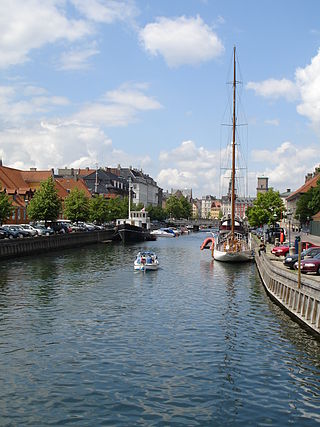
Frederiksholms Kanal is a canal in central Copenhagen, Denmark, which runs along the south-west side of Slotsholmen, together with Slotholmens Kanal separating the island from Zealand. The name also applies to the continuation of Rådhusstræde which follows the canal for most of its course, first on its south side and for the last stretch, from Prinsens Bro and to the waterfront, on both sides of the canal. Several historic buildings face the canal, ranging in size from Prince's Mansion, now housing National Museum, and Christiansborg's riding grounds to the diminutive Stable Boy's House, part of Civiletatens Materialgård, a former storage facility now used by the Royal Danish Academy of Fine Arts's School of Sculpture.

Ny Kongensgade is a street in central Copenhagen, Denmark, connecting Frederiksholm Canal to H. C. Andersens Boulevard. In the opposite direction, The Prince's Bridge connects the street to Tøjhusgade on Slotsholmen.

Ny Vestergade is a street in central Copenhagen, Denmark. It runs from Frederiksholms Kanal to Vester Voldgade and together with Christiansborg's riding grounds, Marble Bridge and Dantes Plads forms an axis between Christiansborg's tower in the east and Ny Carlsberg Glyptotek's dome in the west. The National Museum's main entrance is located in the street.

Stormgade is a street in central Copenhagen, Denmark. It runs from Frederiksholm Canal to H. C. Andersens Boulevard where it turns into Tietgensgade before continuing along the rear side of Tivoli Gardens and Copenhagen Central Station. In the opposite direction, Storm Bridge connects it to Slotsholmen where traffic may continue across Holmen's Bridge to Holmens Kanal, part of Ring 2, or across Knippel's Bridge to Christianshavn and Amager. The name of the street refers to the Swedish Storm of Copenhagen in 1659.

Det Harboeske Enkefruekloster is a Late Baroque building on Stormgade in Copenhagen, Denmark. The charity was founded by Christine Harboe. The building was listed in the Danish registry of protected buildings and places in 1918.
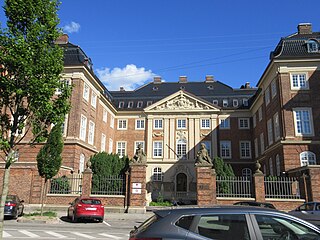
Domus Medica, located on Kristianiagade close to Østerport station in Copenhagen, Denmark, is the headquarters of the Danish Medical Association.

The Schäffer House is an 18th-century, bourgeois townhouse located at Magstræde 6 in the Old Town of Copenhagen, Denmark. The building is also called Hofsnedkerens Gård after Diderich Schäffer for whom it was built. Schäffer's interior Rococo decorations from the first floor are now on display in the National Museum as part of the Magstræde Apartment.

Frederiksholms Kanal 16–18 are two almost identical listed properties overlooking Frederiksholm Canal in central Copenhagen, Denmark. The Victorian Home, a 15-room, late 19th-century bourgeois home now operated as a historic house museum by the National Museum of Denmark, is located on the second floor of No. 18. The Attorney general (Rigsadvokaten) is based at No. 16. Both buildings were listed on the Danish registry of protected buildings and places by the Danish Heritage Agency on 6 April 1969.

Gysbert Wigand Michelbecker was a Danish merchant, shipowner and property owner. He was one of the largest merchants in Copenhagen of his day and was from 1687 the owner of a large property at Frederiksholms Kanal in Copenhagen where the National Museum of Denmark stands today.
